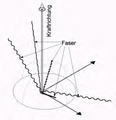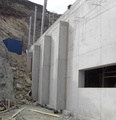Fiber concrete
Fiber concrete is an extension of the artificial building material concrete . Fibers are added to the concrete during production in order to improve the hardening properties and thus also the material properties such as tensile , compressive and shear strength and the fracture and crack behavior. In contrast to concrete, this means that fiber concrete can also take on tensile forces in the non-cracked state. This leads to the possibility of producing any body shape in a statically load-bearing manner.
Cement fiber boards are also available in the building materials trade, which are used in damp rooms instead of gypsum fiber or other drywall boards .
history
Since the invention of concrete by the Romans, fibers made from plants or animal hair have also been added to fresh concrete . The reason was the prevention of shrinkage cracks when setting and thus the security that concrete can also absorb tensile forces. This was taken over from brick production, as the same effect had to be prevented here. The natural fibers were used in concrete and mortar (also in plaster) until the beginning of the 20th century. Only with the introduction of reinforced concrete (in which the steel takes over the tensile forces) was the addition of fibers dispensed with. Today's standards also no longer allow natural fibers in concrete. From 1950, attempts were made with steel fibers, which were mainly intended to avoid shrinkage cracks during the setting process of the fresh concrete . From 1970 onwards, this led to steel fibers coming onto the market as thin wires with a specially curved shape. A little later, glass and plastic fibers were also brought onto the market, with the respective use being divided into different areas of application. Since there was no measurement method comparable to the other building materials, fiber concrete was only permitted as a subordinate building material in guidelines and standards. As a result, load-bearing components should not be made in fiber concrete. Only the evidence from Bernhard Wietek allows fiber concrete to be technically calculated with its necessary parameters such as compressive, tensile and shear strength, although this has not yet found its way into guidelines or standards.
Difference to other building materials
In order to recognize the difference to the usual building materials used in construction in terms of load-bearing capacity, a view of the stress-strain behavior of the building materials is recommended. Here, of all the building materials compared, only the normally permissible range is shown, as this is the linear elastic range in the stress-strain relationship. The possible plastic deformation is not considered here.
It can be seen that most building materials are good in the pressure area, but in the tensile area concrete is particularly bad, since tensile forces allow little or no tension due to the inherent cracks during hardening. Stone and fiber concrete are almost as good as wood, steel is particularly good, which is why steel is often used to transmit tensile forces. Although steel is the ultimate building material, caution is advised because of the slight change in structure due to corrosion.
Fiber concrete has a static effect like a homogeneous building material (stone, wood, steel, concrete) and has its best load-bearing capacity in the uncracked state, like all homogeneous building materials. The post-crack properties can be calculated, but are not decisive for the transfer of the structural loads . In terms of service life, both fiber-reinforced concrete and concrete can be assumed to have a very long service life. This is confirmed by old concrete structures (e.g. Pantheon (Rome) approx. 2,100 years old). Reinforced concrete, on the other hand, acts like a composite material, in which concrete transfers the pressure and steel transfers the tension. This leads to a cracked state that is consciously accepted in the calculation and execution. The steel in the concrete is protected by the alkalinity of the cement stone, but this protection is questionable in the cracked state. There is also a strong risk of corrosion when exposed to the external influence of salts (road and bridge construction). With reinforced concrete used in traffic structures, this leads to a service life of just 30–40 years.
properties
A prerequisite for understanding the properties of fiber concrete is the detailed process in the setting phase of the concrete. To do this, you have to look at the changes in the individual components of the concrete during the setting time. When the cement stone forms crystals, the cement reacts with the water and minerals (cement stone) are formed which take up slightly less volume than the two starting materials. As a result of this process, the concrete contracts a little and there are shrinkage cracks in the concrete. During this process, tensile stresses arise in the fresh concrete which the growing minerals cannot yet absorb, resulting in local cracks that can be more or less large depending on the external conditions (temperature and humidity). As soon as the minerals grow together better, compressive stresses arise in the concrete, which further enlarge the cracks. It is now the task of the fibers to absorb the first tensile stresses in this setting state of the concrete, so that no cracks occur and the concrete is therefore also a homogeneous building material. This means that tensile stresses can also be safely transferred from the fiber concrete in this setting. Corresponding to the elongation during the tensile stress in the fully set fiber concrete, the built-in fibers then also take on a tensile stress that supplements the concrete, so that overall an increased possible absorbable tensile stress is available for the fiber concrete. Corresponding to the relationship with Mohr-Coulomb's law of substances, the tensile stress also increases the compressive stress that can be absorbed, which leads to a considerable improvement in the load-bearing capacity of the fiber-reinforced concrete building material.
Fibers
Only fibers are shown here that are used today with concrete as fiber concrete. There is a very large selection to consider.
Fiber materials
Fiber size
Fiber geometry
dosage
The amount of fibers per cubic meter of concrete is called dosage. This is crucial for the properties of the fiber concrete. For the different fiber materials, the dosages indicated in the adjacent figure are common.
Based on the selected value, the number of fibers per cm 3 and the fiber density per cm 2 must now be specified for the calculation of a dimension .
Distribution of the fiber
Each fiber obviously has a different direction in the concrete. It must first be clarified how the fibers are spatially distributed in the concrete and how they are oriented.
If you look at any configuration of the fibers in relation to the direction of force, you can also move the individual fibers into the origin of the relative coordinate system without changing the spatial influence. An image is then obtained in which all fibers go through the origin and thus the angle between the direction of force and the respective fiber can be measured.
If the fibers are regularly spatially distributed in the fiber concrete, the spatial angle between the fibers is the same, which equates to an equal area on the surface in a hemisphere. If you now distribute these areas on the surface, you can specify the fiber angle for each fiber and thus also calculate the mean value of the angle of all fibers. This results in = 60 degrees.
Composite effect of fibers
The fiber tension in the total cross section can be calculated with the following relationship:
there are:
Fiber tension in the concrete cross-section [kN / cm 2 ]
Concrete shear stress [kN / cm 2 ]
Outer surface of a single fiber [cm 2 ]
area-related dosage [units / cm 2 ]
Geometry factor of the fiber
Solid angle for the spatial distribution of the fibers [°]
Form angle of the fiber [°]
This fiber tensile stress can now be added to the concrete tensile stress and the tensile stress for the fiber concrete is obtained.
Now that the tensile stress of the fiber concrete has been determined, it is also necessary to determine the compressive stress of the fiber concrete. Since the tensile stress of the entire body increases as a result of the addition of fibers, this also has an effect on the compressive stress. This can be seen from Mohr's circle of voltages .
application
Fiber-reinforced concrete has already been used in large numbers and in a wide variety of ways. Since fiber concrete has also proven itself as a non-cracked building material for load-bearing structures, here are some pictures from the most diverse areas of application.
Halls and floor slabs
walls
Girder and inverted T-bar
Tunneling
Stairs and prefabricated parts
Shotcrete sealers
Shotcrete construction pit protection
Foundation for the entrance support Karlesjochbahn 3100m
Calculation programs
FB-Bem or FC-calc
This Excel -based program was developed by the civil engineer Bernhard Wietek and is available in German (FB-Bem) and English (FC-calc) versions. The dimensioning of fiber concrete for the load cases bending, bending with longitudinal force, buckling, shear and punching is calculated here. All concrete grades can be reinforced with fibers made of steel, plastic or glass.
Regulations
There are currently no standards for fiber concrete. Fiber concrete is regulated in the following guidelines, among others:
- German Committee for Reinforced Concrete: Guideline “Steel fiber concrete”, 2010.
- Information sheet steel fiber concrete of the DBV (German Concrete Association)
- Fiber concrete guideline of the ÖVBB (Austrian Association for Concrete and Structural Engineering).
- Leaflet fiber-modified concrete (FMB) - production, processing, fresh concrete testing (Fachvereinigung Faserbeton eV)
literature
- Bernhard Wietek: Steel fiber concrete: Basics and practical application ; Vieweg + Teubner, Wiesbaden 2008, ISBN 978-3-8348-0592-8
- Matthias Dupke: Textile-reinforced concrete as corrosion protection ; Diplomica , Hamburg 2010, ISBN 978-3-8366-9405-6
- Konrad Bergmeister, Frank Fingerlos, Johann-Dietrich Wörner: Concrete Calendar 2011: Power Plants - Fiber Concrete , Ernst & Sohn, Berlin 2010, ISBN 978-3-433-02954-1 .
- Bernhard Wietek: fiber concrete in construction ; Springer Vieweg Verlag 2017, 2nd edition, ISBN 978-3-658-19078-1
Online presentations
- Tunnel in Oberlech with fiber concrete [1]
- Processing of fiber shotcrete with plastic fiber [2]
- Fiber concrete - properties compared to other building materials [3] (PDF; 0.9 MB)
Web links
- Profiling with glass fiber reinforced concrete, Baublatt, December 9, 2013
- Production and properties of fiber-reinforced concrete (accessed August 7, 2020)
- Design of steel fiber concrete components (accessed on August 7, 2020)
- Steel fiber reinforced concrete according to properties and performance classes (accessed August 7, 2020)
- Scatter in the tensile behavior of steel fiber concrete (accessed on August 7, 2020)
















































